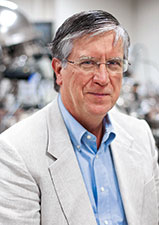APS: The Next Generation
Brighter is always better when it comes to synchrotrons. So the Advanced Photon Source is due for an upgrade.
Northwestern is among the institutions supporting Argonne’s proposal to the U.S. Department of Energy to re-engineer aspects of the beam’s structure and increase its coherent intensity by 100 times.
The upgrade project would put the APS out of operation for about a year. But scientists say that the increase in resolution would be worth the wait. “The Advanced Photon Source has already been a game changer in a lot of different areas,” says Jay Walsh, the University’s vice president for research and professor of biomedical engineering in the McCormick School of Engineering and Applied Science.
The improvements to the beam will make the Argonne synchrotron one of the world’s brightest sources of hard X-rays and the nation’s first fourth-generation synchrotron ring.
This upgrade for the APS will be light years ahead of the first-generation synchrotron sources of the 1970s that ran in a parasitic mode off of a host electron synchrotron storage ring built primarily for high-energy physics.
While most of the power for operating a conventional X-ray tube source goes into unwanted heat, a synchrotron, which accelerates electrons to nearly the speed of light, proved to be extremely efficient at producing highly parallel X-ray beams.

Michael Bedzyk was the first Northwestern professor to get a contract at Argonne, in 1991. Photo by Sally Ryan.
“This is what drove X-ray scientists to work as parasites” at the early synchrotron sources, explains Michael Bedzyk, co-director of the Northwestern Synchrotron Research Center and the first Northwestern professor to get a contract at Argonne, in 1991, when he was hired jointly by both institutions.
Eventually, scientists’ successes in discovering the atomic-scale properties in materials science, physics, chemistry, biology and geology compelled the U.S. Department of Energy to fund a second-generation X-ray synchrotron source at Brookhaven National Lab on Long Island in the early 1980s that was dedicated to and optimized for X-ray science.
“Each decade has seen accelerator physicists designing machines with overwhelming improvements in producing brighter and brighter X-ray beams,” adds Bedzyk. “This led to the creation of the Advanced Photon Source, a third-generation synchrotron, built for $400 million in the 1990s.
“And now there’s a new proposal to rebuild it by the early 2020s.”
It’s the next generation synchrotron, and Northwestern scientists will likely play a critical role in the upgrade as leaders in the world of X-ray science, says Bedzyk.



 Facebook
Facebook Twitter
Twitter Email
Email


